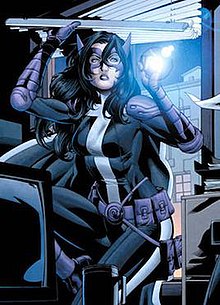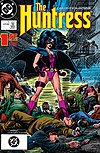Huntress (comics)
| Huntress | |
|---|---|

Helena Wayne as Huntress in Huntress vol. 3, #2
(January 2012). Art by Marcus To. |
|
| Publisher | DC Comics |
| First appearance | Sensation Comics #68 (August 1947) |
| Created by | Mort Meskin |
| Characters |
Paula Brooks Helena Wayne Helena Bertinelli |
| The Huntress Huntress |
|
 |
The Huntress vol. 1, #1 (Apr, 1989). Featuring the Helena Bertinelli version of the character. Art by Joe Staton. |
| Series publication information | |
| Publisher | DC Comics |
| Schedule | Monthly |
| Format |
(vol 1) Ongoing series (vol 2) Limited Series |
| Genre | |
| Publication date |
(vol 1) April 1989 – October 1990 (vol 2) June – September 1994 |
| Number of issues |
(vol 1) 19 (vol 2) 4 |
| Main character(s) | Helena Bertinelli |
Huntress is a superhero appearing in American comic books published by DC Comics, commonly in association with Batman. Several characters have assumed the Huntress superhero identity, with the Huntress of the Golden Age having been a supervillain.
The Golden Age Huntress was a supervillain with the real name of Paula Brooks who battled the superhero Wildcat, first appearing in Sensation Comics #68. She joined the second Injustice Society of America and stole the Plymouth Rock. She married fellow supervillain Sportsmaster.
The character was later retroactively renamed the Tigress in the pages of Young All-Stars. These stories took place prior to her villainous career. At this point, the young Paula Brooks was a super-heroine, and fought both Nazis and criminals as a Young All-Stars member.
The Bronze Age Huntress was Helena Wayne, the daughter of the Batman and Catwoman of Earth-Two, an alternate universe established in the early 1960s as the world where the Golden Age stories took place. Earth-Two was also the home of the Golden Age versions of various DC characters.
Created by Paul Levitz, Joe Staton, and Bob Layton, her first appearance was in All Star Comics #69 (December 1977) and DC Super Stars #17, which came out the same day and revealed her origin. She appeared in Batman Family #17-20 when it expanded into the Dollar Comics format for its last few issues. The bulk of her solo stories appeared as backup features in issues of Wonder Woman beginning with issue #271 (September 1980).
...
Wikipedia
